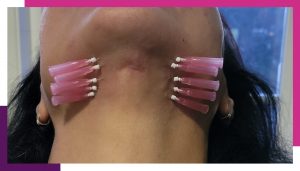PDO Thread lift
What Is a Polydioxanone (PDO) Thread Lift?
A thread lift is a procedure that uses a dissolvable suture to tighten and lift your skin. It’s a less invasive procedure than facelift surgery and can often be performed in under 45 minutes without needing to go under a scalpel.
Polydioxanone (PDO) thread lifts use a biodegradable polyester suture. They’re best suited for rejuvenating your skin while some newer types of thread lifts are better at lifting sagging skin.
Let’s take a look at what makes a PDO thread lift different from other thread lifts and what you can expect during the procedure.
What makes PDO threads different?
PDO threads are one of three types of sutures commonly used in thread lift procedures. The other two types are made from polylactic acid (PLA) and polycaprolactone (PCA).
PDO threads have been around the longest of the three and have been used in surgeries since the 1980s. They’re made from a colorless polyester that breaks down in your body after about 6 months.
The presence of these sutures in your skin triggers cells in your body called fibroblasts to produce more collagen. Collagen is the protein that gives your skin its structure and elasticity. Loss of collagen is one of the main causes of aging skin.
PDO threads can be further divided into three categories:
- PDO mono threads. Smooth sutures that help rejuvenate your skin by stimulating collagen production.
- PDO cog threads. These threads have barbs that latch into your skin like small fishhooks, to provide support and lift parts of your face.
- PDO screw threads. Made up of one or two intertwined threads, these are used to help restore volume to sunken parts of your skin.
Other types of threads
PLA and PCA threads are newer than PDO. They last longer in your body and tend to stimulate more collagen production. PLA threads take about 12 months to be absorbed and PCA takes about 12 to 15 months.
Each type of thread is best suited for a particular function. PDO threads are better at repositing and revitalizing tissue while PLA and PCA threads are better at lifting sagging parts of your skin.
PDO thread lifts have a much lower risk of complications than facelift surgeries. There’s less risk of scarring, severe bruising, or bleeding when performed by a trained professional.
Minor complications occur in 15 to 20 percent of procedures but are usually easily corrected. Potential complications include:

- visible sutures (especially in people with thin skin)
- pain
- minor bruising
- infection
- snapping of threads
- accumulation of blood (hematoma)
- inflammationTrusted Source
- dimpling (orange peel-like skin texture)
- hair loss
- inflammation
- salivary gland injury
What areas of the face can a PDO thread lift treat
PDO Thread lift can treat most parts of your face that are experiencing signs of aging. The areas around your cheeks, jaw, neck, and eyes are among the most commonly treated areas.
Because the results of thread lifting aren’t as drastic as the results of facelift surgeries, thread lifts are commonly used together with other anti-aging procedures such as ul therapy or dermal fillers.
The authors of a 2019 study trusted Source found that a PDO thread lift caused immediate improvements in skin sagging after the procedure. However, there was a noticeable decline in results 6 months later. Improvements were no longer apparent after 1 year.
In a study trusted Source published in Aesthetic Surgery Journal, a surgeon with 16 years of thread lift experience says he has seen results last anywhere from 1 to 9 years. Younger people tend to have results that last 3 to 4 years. Older people with poor skin volume or elasticity tend to only see benefits for 1 to 2 years.
PLA and PCA thread lifts tend to last longer since the sutures take longer to dissolve.
You’ll likely be advised to avoid alcohol and tobacco use at least 5 days before your procedure, along with anything else that may increase the risk of bleeding or bruising, such as:
- Advil and ibuprofen
- aspirin
- omega-3 fatty acids
- green tea or green tea extracts
On the day of your procedure, your doctor will talk you through the potential complications and give you advice about your recovery.
The exact procedure Trusted Source your surgeon will follow can vary. In general, it will probably look something like this:
- As you sit in a reclined seat, your surgeon will disinfect your face with alcohol. They’ll apply a local anesthetic with a needle under your skin.
- Your surgeon will make a small incision with another needle and then insert a device called a cannula into the small hole.
- Your surgeon will anchor the thread into place and pull out the cannula.
- They’ll finish by cutting the thread and making sure it’s secure in place.
You’ll be free to go home shortly after the procedure.
Recovery from a PDO thread lift is minimal. You may have some swelling and bruising for the first 24 to 48 hours but you can return to most of your daily routines right away.
You should avoid rubbing your face as much as possible the week after your procedure to avoid accidentally dislodging the thread. You’ll also likely be advised to avoid pursing your lips, smoking and drinking through a straw for the first several weeks.
Other activities you may want to avoid for 1 to 2 weeks include sleeping on your side, intense exercise, and visiting saunas.
Sleeping with your head propped on a pillow can help you avoid accidentally rolling onto your face during the middle of the night.

